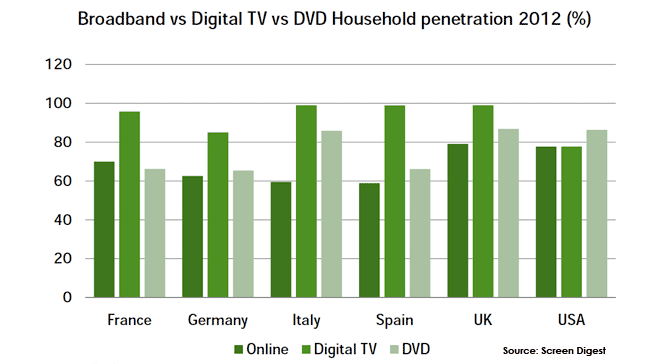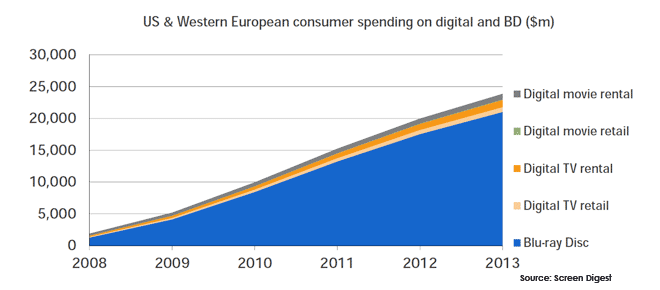Europe's online source of news, data & analysis for professionals involved in packaged media and new delivery technologies

Packaged media still good business, but no room for complacency
“The fundamentals of our business are still viable, but let’s not be complacent,” enjoins David Bishop, President, Worldwide, Sony Pictures Home Entertainment, in his PEVE keynote address to 250 delegates last month in Paris. “Our industry is developing a variety of new digital entertainment options to create additional sales, rentals and subscription. So, we have the business model that will sustain us into the future. If people consumes more products, we will be there.” This neatly encapsulates the range of topics tackled at the Paris conference organised by Screen Digest, JEAN-LUC RENAUD reports.
Despite the economic downturn, the home entertainment sector is still holding well. It is a $50bn a year business. Home entertainment represents 70% of what the studio brings to the Sony group.
Notwithstanding the encouraging 37 million Blu-ray discs sold last year globally, the industry needs to do a better job to promote the hidef format to the consumers. “Collectively, we put our feet up once the format war went away and we are not as aggressive as we used to be,” laments Bishop.
Ironically, as Blu-ray disc sales are picking up, the industry is now facing a barrage of media criticism that creates a perception that business performance differs from reality. Will audience bypass DVD as it is offered a wide range of online delivery options? Are the studios propping up a product that is loosing momentum while the industry is buying time to rethink the business model?
Figures are encouraging indeed. In the US, HDTV household penetration is approaching 50% and, by the end of 2009, Europe will count 78 million HDTV homes. Sony research reveals that more than 50% of what people watch on their HDTV in the US is already in high definition, be it via cable, satellite, telecom or over-the-air broadcasting. Some 30% of HDTV homes own a BD player, and 70% already believe BD delivers a better picture than DVD.
Providing a digital copy of a movie is part of the roadmap as well. Already 100 BD title include a digital copy compatible with portable devices. “A digital copy elevates the value of physical media by building a bridge to the digital world. The BD disc has been specifically designed to serve as an evolving medium,” says Bishop.
Eddy Cunningham, President, Universal Pictures International Home Entertainment, echoes his colleague at Sony. “Eighty percent of our staff got into this industry when it grew double-digit. That’s no longer the case, but it does not means the industry is in trouble.”
“That is a good time to invest, not to retreat. There is a huge job to do with Blu-ray. In Europe, we are not doing it that well, we need to change gear,” argues Cunningham, “absolutely convinced” that BD is going to be the format “for the next few years.”
Whereas the Digital Entertainment Group counts 75 member companies to promote the hidef format in the US, and 45 are doing likewise in Japan, DEG in Europe is only 8-strong “when everyone shows up,” laments Cunningham.
Differential BD and DVD catalogue pricing is a matter of concern to the Universal executive who sees it as critical to preserving the value of the content the industry produces. In order to avoid bringing the BD catalogue price down too drastically, he hinted that there might be a case for raising the DVD catalogue price tag.
Piracy was close to his preoccupation. Some 90 million “copies” were downloaded “unpaid” last year versus 150,000 paid downloads. “If we can reduce the former by a few percents, it will get us into double-digit growth.” The “Knock-off Nigel” campaign in the UK aimed at deglamourising the purchase of pirated discs seems to be working. Before the campaign, 20% of 16-34 year-old youngsters saw the habit of buying pirated discs as downmarket, sleazy. Eighteen months later, that figure rose to 52%.
As for online delivery strategies, Cunningham warns the home entertainment industry to be careful “not to swap analogue dollars for digital cents.”
The Blu-ray session brought to the forth – once again – the “extortionate” cost of AACS licensing for independent replicators, and the challenges of competing against Sony DADC.
“The AACS charges four times,” says a disgruntled Laurent Villaume, CEO of French replicator QOL. “A licensing contract for the publisher, a license for the replicator at $15,000/year plus a $1,250 key per title, and €0.03 per disc. Given that piracy is taking away a lot of revenue potential, spending all this money on AACS is ridiculous, especially on catalogue titles.” This AACS cost is an obstacle to the growth of BD, because a number of independent publishers would like to release movies, but the fixed cost is too high particularly at this point in time when sales are still modest.
Screen Digest invited AACS LA to answer these concerns, but “the anticipated imminent release of our final specifications and the licenses prevented us from coming to PEVE,” said the Los Angeles-based organisation in a fax that repeated nearly word-for-word the message sent to PEVE the previous year. “We are confident that our soon-to-be-released final documents will demonstrate our determined efforts to make AACS even more accessible to all who wish to participate to the Blu-ray market,” the fax concludes.
Not only is authoring and premastering of a BD disc complicated operations, but having to redo a test disc because of a mistake, however small, requires a new, expensive AACS key. “It’s already a complicated process and very expensive for smaller content owners,” notes Chris Nealy, VP European Operations, Sonic Solutions. “The system is set up for the big studios. It needs to be affordable to smaller studios. After all, DVD became a big success when it spread outside the Hollywood studios. AACS LA needs to reflect this reality.”
Delegates were reminded, however, that the AACS keys of all BD titles have been cracked and available on the Internet. And the optional BD+ protection has been compromised as well. Macrovision, who owns the BD+ technology, said that their extra security layer acts as a speed bump, letting the legitimate copy enough breathing space before the pirated copy eats into the revenue.
Another recurring theme is the difficulty for independent replicators to compete with “BD inventor, manufacturer, distributor” Sony DADC – who control nearly 90% of the market. “A level-playing field via a global licensing system for disc and players is in order,” said QOL’s Villaume. “I had feared that some companies did not want to play the BD games on the basis of the sharing of royalties.” He now welcomes the new partnership Sony has joined with the other French companies.
With a monopoly on the manufacturing side, Sony DADC does not make it easy for the other replicators to commit the huge investment necessary,” argues Jean-Michel Cathonnet, VP European Logistics & Distribution, Cinram. “If Hollywood studios will not share their production requirements with independent replicators with local knowledge, as was the case with VHS, they will be faced with a dearth of capacity as DVD replicators will have little incentive to convert to Blu-ray.”
It remains that investment in BD facilities is huge, owing to the lack of competition in the provision of pressing tools. “We have no access to Sony manufacturing equipment. So far Singulus is the only supplier,” complains Villaume. “So, there is not downward pressure on price. A BD replication line costs €2m to press 10-12,000 BD discs per day when a DVD line cost €800,000 for 35,000 disc a day.”

The impact of the economic downturn on the home entertainment sector depends on where one stands in the chain. Sonic’s Nealy notices there is not the same rush to Blu-ray as the one observed towards DVD “when everybody was so excited to get into the game.” “Because the BD infrastructure investment are so significant, it’s a difficult decision to make right now. People are waiting until they have orders before committing BD investment, with DVD is was the other way around. And right now money is hard to find. It tends to be through leasing companies.”
For its part, Isaac Larbi, SVP Strategy & Sales at authoring equipment maker Sofatronic in the US, does not see a slowdown in BD titles being produced in the US. Sure, studios are laying off, they are more cost-conscious, but they produce more lower budget titles. The situation in Europe is less encouraging because of the smaller HDTV installed base to sustain the BD production.
QOL’s Villaume is not overtly concerned with the seemingly leisurely pace of BD adoption because he sees Blu-ray as a new high definition support rather than a replacement to DVD. “We are no longer in the same playground as DVD. BD has new competitors like HD satellite channels, but at 5-10Mbit bitrates HD broadcasting is no quality match for the up to 43Mbits bitrates of a BD disc. That’s why we are five years ahead of the competition. BD also offers the true cinema experience as it runs 24 fps and not 25 as on TV. On the audio front, BD offers DTS HD at up to 25Mbit whereas DVD audio is limited to 1.5Mbit.”
“It is only in 2009, 2010, 2011 that we all experience the big push for BD. Before talking BD we have to talk High Definition in homes. So, there is no urgency, the market will develop in time.”
Given that Wal-Mart’s commitment to Blu-ray and its abandonment of HD DVD is widely seen has having put the final nail in the latter’s coffin, large retailers have becoming powerful in determining the fate of Blu-ray market inroads.
Rob Salter, Category Director Entertainment at the UK’s No1 supermarket chain Tesco, describes the dilemma he faces. “Our BD section is small. How many times can we ask the customers to pay for the same thing? Consumers have multiple DVD players in the house, so it is a challenge for the customer to change all their machines to accommodate a new format. Perhaps the solution is to sell a combo DVD/BD box at least during a transition period, and assuming BD makes it big. Pricing may be an issue. In the final analysis, ownership of content may no longer be seen simply as a DVD sitting on the shelf.”
Shelf space is precious. To provide greater breath of content is a must. “Kiosks could be an option, but cost and time to wait for burning disc to is problematic. And installing several kiosks in each store together with their management represents massive investment,” add Salter.
His more immediate concern is the cost of returns. Tesco spends £3.5 million a year returning products to suppliers. “It’s a complete waste of money, the current model does not make sense.” It was probably time to review the current home entertainment supply chain model, under which up to 20 per cent of DVDs shipped are subsequently returned unsold to distributors.
Is going green conflicting with economic necessity? No, says Aodan Coburn, EVP Worldwide Operations, Sony Pictures Home Entertainment, setting out the company strategy.
“Home entertainment companies represent more than 50% of the carbon footprint for the studios. From 2006 to 2009 our objective is a 20% reduction, then 10% reduction on an annualised basis. There is a myth that sustainability is a luxury with a cost to it. There are some elements that may have a cost, but sustainability is often doing the right thing for the right reasons. It’s about going back to the supply chain and questioning how things are done. In Central Europe, we now ship new releases to retailers directly from the replicators that was not something we did in the USA. This had immediate impact on our carbon footprint, saved us money, save our partner investment costs.”
The conference also looked forward to the arrival of 3D content in the home. Theatrically, 3D is already a reality and the amount of 3D content is set to ramp up; furthermore, everyone agrees that Blu-ray is an ideal platform for bringing it to the home. However, despite the involvement of several industry bodies there are as yet no signs of a single industry standard; a real concern for an industry still reeling from a previous format war.
Digital video delivery is not longer confined to a PC. Television is moving into the digital space, as Jim Taylor, Chief Technologist, Sonic Solutions, put it. The living-room TV together with the full range of consumer electronic devices will become the Internet-connected display devices par excellence. Though after eight years and a $40 million investment, CinemaNow, which Sonic acquired, has yet to show a profit, Taylor is confident, that is the way to go.
“The idea is to buy content independent of the format that it is delivered on,” Taylor explains. “You buy something once and you get a physical disc you can play on multiple devices and you can stream it anywhere. For example, you buy a video from CinemaNow, you can stream it to an LG player, you can put it on your mobile phone, you can stream it to a Yahoo TV widget player, you can burn a DVD, and you can put it on your Archos portable device. This will extend the value of digital content when you can buy it once and distribute across multiple devices.”
The legacy business model dealing with release windows is an impediment to rapid “connected TV” adoption. Windows are shrinking, but they will not disappear anytime soon especially since there are thousands of contracts in place.
It takes a long time to shift formats. “There is consumer resistance to another box, so in the long term this connected technology has to be built into the TV set,” says Taylor. “True, viewers may not want to browse Internet on their TV, because so far websites are created for PC or portable devices. But in the future people will create websites for the TV platform as well. It will take a decade or so before this business model takes off, but it will transform the industry and hold a lot of opportunities.”
The last word was left to Olivier Robert-Murphy, VP International USM, Universal Music Group, who cited Charles Darwin. “It is not the strongest of the species that survives, nor the most intelligent that survives. It is the one that is the most adaptable to change.”

Story filed 27.04.09




















